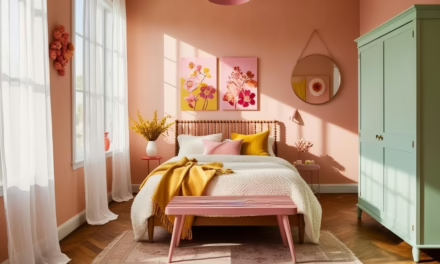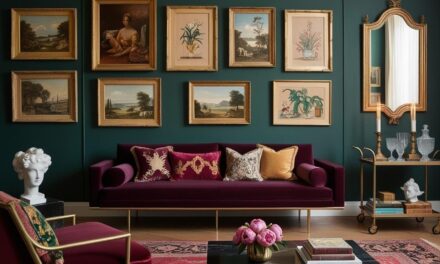7 Steps for Creating a Maximalist Dining Room with Bold Colors and Textures

Remember when everyone was Marie Kondo-ing their dining rooms into submission, and personality became something to minimize rather than celebrate? Well, I’m here to tell you that the pendulum has swung back in the most delicious way. Maximalism isn’t just having a moment – it’s throwing a full-on dinner party, and everyone’s invited.
Let me share something that changed everything for me: I was helping a client who had been holding onto this gorgeous vintage chandelier for years, too afraid to hang it because it “didn’t match” her modern dining table. The day we finally installed it, paired it with bold wallpaper, and surrounded it with an eclectic mix of chairs? Pure magic. That’s when I realized that sometimes the best design decisions happen when we stop playing it safe and start playing favorites.
Here’s the thing about creating a maximalist dining room: it’s less about following rules and more about following your joy. Think of it like hosting the perfect dinner party – you want a mix of personalities that create interesting conversations, not a room full of people who all say the same thing.
In this guide, we’ll explore everything from choosing bold colors that make your heart sing to mixing patterns that shouldn’t work (but totally do). I’ll share some of my favorite “happy accidents” that turned into design principles, and yes, even a few spectacular fails that taught me what not to do. Because let’s be honest – sometimes the best way to figure out what works is to get it wonderfully wrong first.
Whether you’re just dipping your toe into the maximalist waters or ready to dive into the deep end, I’ve got your back. We’ll talk about practical things (like how to keep your bold choices from overwhelming your space) and fun things (like why that quirky art piece you love might be exactly what your dining room needs).
Ready to create a dining room that’s as unique as your dinner party conversations? Let’s dive in!
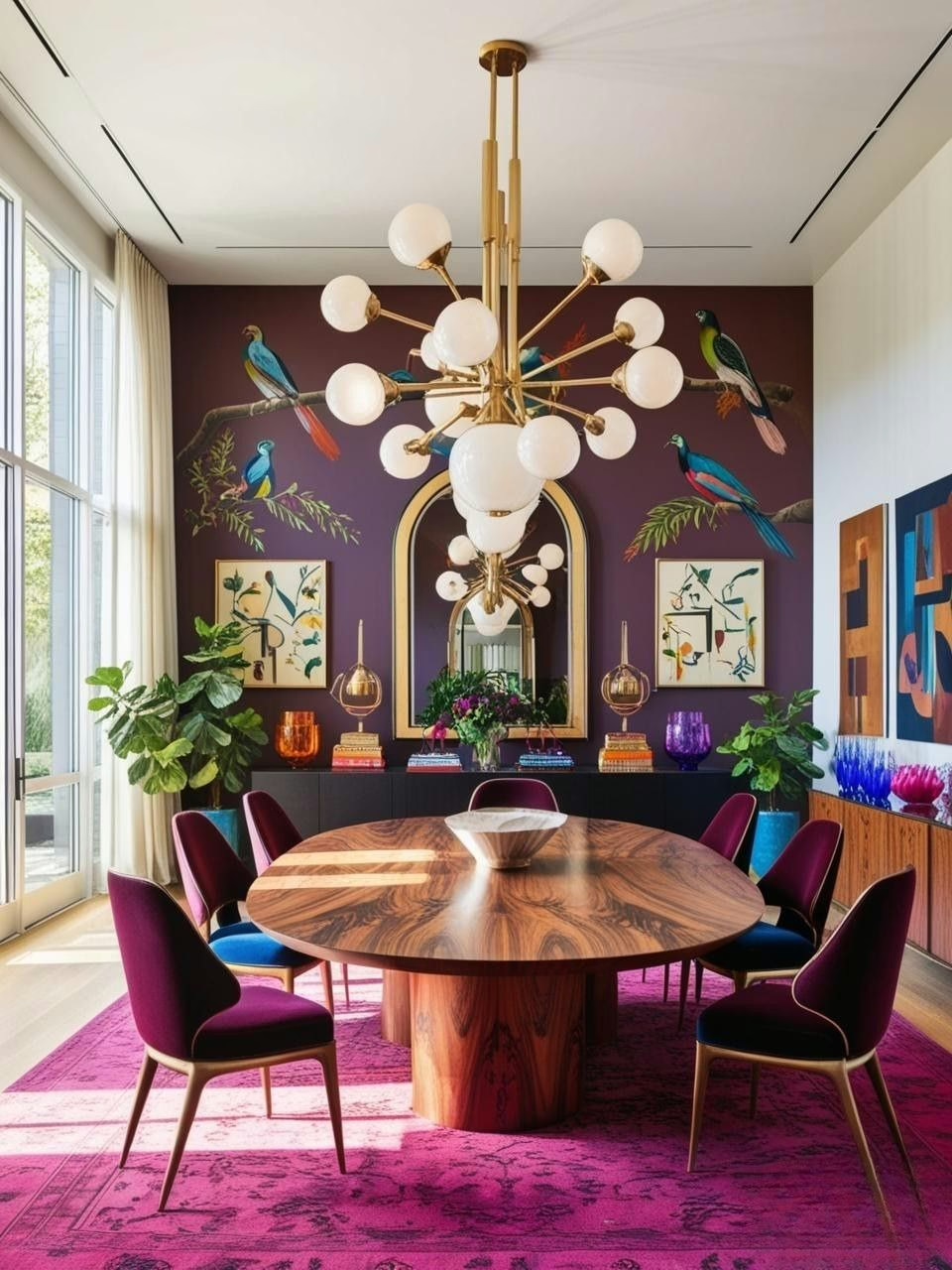
Understanding the Maximalist Dining Room Trend
Remember when the design world convinced us that the perfect dining room meant stark white walls and a single orchid on an empty table? Those days are officially over, and I couldn’t be more excited. Maximalism isn’t just a trend – it’s permission to let your dining room tell your whole story.
What Really Makes a Space Maximalist?
Think of maximalism as your favorite playlist on shuffle. Just like you can love both vintage jazz and modern pop, your dining room can rock a mix of bold patterns, rich textures, and unexpected color combinations. I’ve seen spaces where Victorian chairs slide up to sleek marble tables, and somehow, it just works. The key isn’t how much stuff you have – it’s about creating intentional layers that reflect your personality.
Breaking Free from the Minimalist Mindset
For years, minimalism had us all believing that a “grown-up” dining room meant fifty shades of beige. But here’s what I’ve discovered working with different spaces: some of the most sophisticated dining rooms are the ones that dare to be different. That vintage buffet you inherited from your grandmother? It might look amazing paired with modern art and bold wallpaper. Those mismatched dining chairs you’ve collected over the years? They could be the start of something spectacular.
Making Your Dining Room Feel Like You
The best part about embracing maximalism is that there’s no template to follow. I once worked with a space where we paired a crystal chandelier with street art, and it became the most talked-about room in the house. The magic happens when you stop trying to fit your style into a box and start asking yourself what makes you smile when you walk into the room.
Some practical ways to start embracing your maximalist side:
- Start with pieces you absolutely love and build around them
- Play with unexpected combinations – like pairing traditional china with modern linens
- Add layers gradually rather than trying to transform the space overnight
- Think of your dining room as a gallery of your favorite things, not just a place to eat
Remember, maximalism isn’t about cramming every trend into one space. It’s about creating a dining room that feels alive with personality – yours. Whether that means hanging your grandmother’s plates next to contemporary art or mixing patterns that technically shouldn’t work together (but somehow do), the only rule is that it should make you happy every time you sit down for a meal.
Want to know the moment I knew maximalism was more than just a trend? When I realized my clients stopped apologizing for wanting to keep their “mismatched” pieces and started getting excited about making them work together. That’s when design gets really interesting – when we stop following rules and start following our instincts instead.

Choosing Bold Colors for a Maximalist Dining Room
You know that feeling when you walk into a room and instantly feel energized? That’s the magic of bold color done right. I’ll never forget the time I helped transform a dining room by painting the ceiling emerald green – the owner’s husband thought we’d lost our minds until he saw how it made their vintage brass chandelier absolutely sing.
Creating Your Color Story
Let’s talk about combining those juicy, bold colors that make your heart skip a beat. Remember color theory from art class? Well, forget most of it. While complementary colors look great on a wheel, real rooms need a bit more nuance. I’ve found that picking one statement color (like that emerald green ceiling) and building around it works better than trying to coordinate three bold colors at once.
The Secret to Making Bold Colors Work
Here’s something that took me years to figure out: bold doesn’t have to mean bright. Some of the most striking dining rooms I’ve worked with use deep, saturated colors instead of neon brights. Think midnight blue walls with mustard velvet chairs, or a deep plum accent wall behind a vintage sideboard.
A few tried-and-true combinations that rarely fail:
- Emerald green with warm brass and cream
- Cobalt blue with rust orange and soft gray
- Mustard yellow with charcoal and ivory
- Deep plum with sage green and natural wood tones
Playing with Paint
Want to know my favorite trick for testing bold colors? Paint large poster boards instead of tiny swatches on the wall. Move them around the room throughout the day – you might be surprised how that perfect peacock blue looks completely different between your morning coffee and dinner time.
For the ceiling-painting curious (and yes, you should be curious), here’s what I’ve learned:
- Darker colors make tall ceilings feel more intimate
- Glossy finishes reflect light in magical ways
- The right ceiling color can make your light fixtures look like they cost twice as much
Beyond the Walls
Bold color isn’t just about paint. I once worked with a client who was nervous about committing to bold walls, so we brought in color through furniture instead. Her cobalt blue dining chairs became the talk of every dinner party, and the best part? They’re easier to change than painted walls if she ever wants to switch things up.
Here’s a pro tip I wish I’d known sooner: start with your textiles. Whether it’s curtains, chair cushions, or a statement rug, fabric is often the easiest way to experiment with bold color combinations. Plus, if you fall in love with a particular combination, you can always commit to it with paint later.
Remember, there’s no such thing as a color mistake – just happy accidents that lead to even better ideas. That time I paired hot pink with terracotta and everyone thought I was crazy? It ended up inspiring a whole new approach to warm-cool color mixing. Sometimes the best color stories start with being brave enough to try something different.
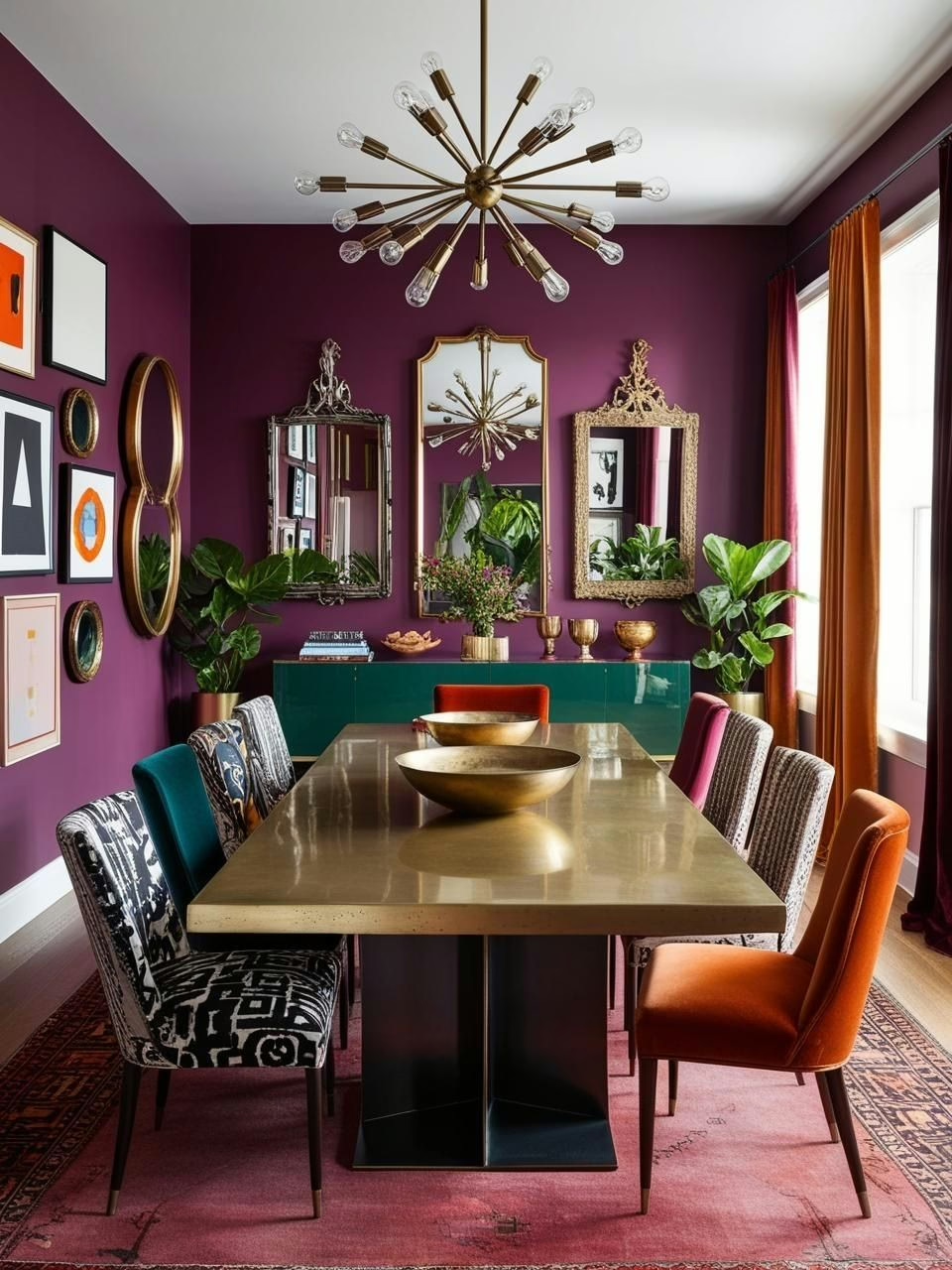
Mixing and Matching Furniture for Eclectic Appeal
Confession time: I once spent three months trying to find chairs that perfectly matched my vintage dining table. Want to know what finally worked? The mismatched set I borrowed for a dinner party while still hunting for “the ones.” Sometimes the best design decisions happen when we stop trying so hard to make everything match.
The Art of the Mix
Here’s what I’ve learned after years of playing furniture matchmaker: your dining table and chairs are more like a dinner party guest list than a matching set. Just like you wouldn’t invite eight of the exact same person to dinner, your dining room doesn’t need eight identical chairs. I once paired a sleek marble table with vintage velvet chairs, and honestly? It was like they’d been waiting their whole lives to meet each other.
Breaking Up the Sets
Remember when everyone’s dining room looked like it was teleported straight from a furniture showroom? Those days are gone, and thank goodness. Some of my favorite combinations have happened by accident:
- A glass-topped modern table with French bistro chairs
- An antique oak table surrounded by slim-lined metal seats
- A rustic farmhouse table playing nice with lucite ghost chairs
Pro tip: Start with your statement piece (usually the table) and think of your chairs as the supporting cast. They don’t need to match – they just need to make your table look good.
The Material World
Let’s talk about mixing materials, because this is where the magic really happens. I had a client who was nervous about combining her grandmother’s mahogany table with modern metal chairs until we added leather cushions that somehow made everything click. The secret? Having one element that ties different pieces together.
Here’s my tried-and-true formula for mixing materials:
- Always include something warm (wood, leather, velvet)
- Add something that reflects light (glass, polished metal, mirrors)
- Throw in something tactile (woven textures, rough metals, natural fibers)
Making It All Work Together
You know that moment when you’re cooking and you throw in a random ingredient that somehow makes the whole dish better? That’s what happens when you mix furniture styles correctly. I once saved a too-traditional dining set by adding two super-modern end chairs in a bold velvet. They were like the salt that made everything else taste better.
A few tricks I’ve picked up along the way:
- Use color to unite different styles (like painting mismatched chairs the same shade)
- Keep proportions similar even when styles differ
- Look for repeated elements (curved lines, similar leg styles) that create subtle connections
Here’s the thing about mixing furniture: there’s no real formula. It’s more like jazz – you need to understand the basics before you can improvise. But once you get it? That’s when your dining room starts to feel like it’s got a personality all its own. And isn’t that what we’re really going for?
Remember that time I mentioned borrowing mismatched chairs? They never left. Sometimes the best design decisions are the ones we don’t overthink. So go ahead, mix that contemporary table with vintage chairs. Put that industrial light fixture over your grandmother’s table. If it makes you smile when you walk in the room, you’re doing it right.

Textures and Patterns That Make a Statement
Let’s talk about my favorite design plot twist: the moment I realized my “pattern mixing disaster” was actually the start of something amazing. Picture this – I had just layered a striped rug under a floral-cushioned dining set, and my colleague walked in and said, “Now that’s interesting!” (And she meant it in a good way!)
The Texture Tango
You know how some people can mix prints like they were born doing it? Well, I wasn’t one of them – until I discovered the secret sauce: texture. It turns out, adding different textures to a space is like adding seasoning to a dish. That velvet chair I was nervous about? It became the perfect complement to a rough-hewn table, especially after adding a metallic centerpiece that caught the light just right.
Here’s what I’ve learned about layering textures:
- Start with your largest surface (usually the rug) and build up
- Mix rough with smooth, matte with glossy
- Always include something touchable – dining rooms shouldn’t just be pretty to look at
Pattern Play Without the Panic
Remember when mixing patterns felt like trying to solve a Rubik’s cube blindfolded? Here’s what finally clicked for me: patterns are like party guests – they need something in common to get along. Maybe it’s a color, maybe it’s a shape, but there needs to be that one thing that makes them nod at each other across the room.
My go-to pattern combinations that rarely fail:
- Large-scale florals with tiny geometric prints
- Bold stripes with subtle organic patterns
- Abstract prints with classic motifs (my personal favorite pairing)
The Cozy Factor
True story: I once created what I thought was the perfect pattern mix in a dining room, but something felt off. Know what was missing? Those subtle texture layers that make a room feel lived-in. We added a nubby table runner, some leather-bound chairs, and suddenly the space went from “look but don’t touch” to “please stay for dessert.”
Some texture-building tricks I’ve picked up:
- Layer different weaves in similar colors
- Mix natural materials with polished finishes
- Include at least one super-tactile element that begs to be touched
Making It All Work
Here’s a little secret I wish someone had told me years ago: start with your favorite pattern and let it be the boss. Everything else should play a supporting role. That wild botanical print you’re in love with? Perfect. Now find patterns that complement it without competing for attention.
A few real-world combinations I’ve seen work beautifully:
- A geometric rug under a table with floral-print chairs
- Striped wallpaper with textured grasscloth panels
- Chevron curtains playing nice with scaled-down animal prints
Remember that time I mentioned my “pattern mixing disaster”? Well, here’s the thing – it taught me that sometimes you need to step back and let patterns get to know each other. Like any good relationship, it takes time. That striped rug and floral cushions? They’ve been happily married in my client’s dining room for years now.
The best part about mixing patterns and textures is that there’s always room for one more layer. Just when you think a room is finished, you might find that perfect textured vase or patterned table linen that adds exactly what you didn’t even know was missing. It’s like decorating jazz – you have to feel it more than follow rules.
Your Shortcut to Effortless Desert Modern Style
12 refined color palettes & implementation strategies designed to bring sophistication, texture, and harmony into your home.

Creating a Showstopping Centerpiece for Your Dining Table
You know that moment when someone walks into your dining room and stops mid-sentence? That’s what we’re going for with centerpieces. Though I should mention – this revelation came after my own centerpiece disaster involving a massive glass bowl that was so big my dinner guests had to do that awkward lean-and-peek dance just to see each other. Live and learn, right?
Going Bold Without Going Overboard
Here’s something that took me way too long to figure out: the most striking centerpieces aren’t always the biggest. I once created a display using a collection of vintage perfume bottles filled with single stems, and it totally stole the show. The secret? It had personality but still let people pass the salt without playing Jenga.
Some centerpiece ideas that have earned their keep:
- A cluster of different-height glass vases with monochromatic flowers
- An oversized vintage bowl filled with seasonal fruit (bonus: you can actually eat it!)
- A collection of sculptural objects in varying heights and materials
- A dramatic branch arrangement that adds height without blocking sightlines
Mixing the Natural with the Notable
Want to know my favorite centerpiece trick? Combining something living with something luxe. Picture this: I once paired a wild arrangement of monstera leaves with a collection of brass candlesticks, and honestly? It looked like it belonged in a magazine. The organic shapes of the leaves made the metallic elements feel less precious, and the brass made the greenery look more intentional.
The Height Question
Let’s talk about the elephant in the room – height. After my tower-of-Babel centerpiece moment, I developed what I call the “chin rule”: if you have to lift your chin to see the person across the table, your centerpiece is too tall. Unless you’re going for that “I don’t actually want to talk to my dinner guests” vibe (no judgment!).
Some height-savvy strategies:
- Keep tall elements thin and see-through (like delicate branches)
- Create visual interest at different levels
- Use low, wide arrangements for intimate dinners
- Save the dramatic height for parties where people won’t be seated long
Seasonal Switches
Here’s a little secret: your centerpiece doesn’t have to be a one-hit wonder. I love helping clients create a “centerpiece wardrobe” – a collection of vessels and objects they can mix and match throughout the year. That concrete bowl that holds pine cones in winter? Try filling it with citrus in summer. Those brass candlesticks? They work year-round, just change what’s around them.
Remember that time I mentioned my too-big glass bowl? Well, it found a perfect home – on my client’s coffee table, where no one needs to see through it. Sometimes the best centerpiece solution is realizing when something belongs somewhere else entirely. Because at the end of the day, your centerpiece should make your dining room more inviting, not more complicated.
Pro tip: If you’re ever unsure about a centerpiece, invite your most honest friend over for coffee and watch how they interact with it. If they have to move it to see you, or worse, if they don’t even notice it – time for a rethink!

Lighting That Complements the Maximalist Dining Room
True story: I once walked into a client’s dining room where they’d hung this absolutely gorgeous vintage crystal chandelier. The only problem? It was giving off all the romantic ambiance of an airport runway. Turns out, even the most spectacular light fixture needs a supporting cast to really shine (pun absolutely intended).
The Drama of Statement Lighting
Let me tell you about my favorite lighting revelation: sometimes the most “obvious” choice for your space is exactly right. You know that oversized brass pendant you’ve been eyeing but worried might be “too much” for your maximalist dining room? Spoiler alert: in a maximalist space, “too much” is often just enough.
Here’s what I’ve learned about choosing statement pieces:
- Go bigger than you think (I once undersized a chandelier and had to order its big sister a week later)
- Consider your ceiling height – but don’t let it completely limit you
- Think about the mood you want to create, not just the style that “matches”
- Remember that dimmers are your best friend (more on that in a minute)
Layering Light Like a Pro
Remember how we talked about layering textures? Well, lighting layers are just as important. I had this moment of clarity when helping a client who complained her gorgeous dining room looked “flat” in the evening. The fix? We added wall sconces that highlighted her art collection and suddenly – magic!
My go-to lighting layer combo:
- Statement overhead piece (your show-stopper)
- Wall lighting (sconces or picture lights)
- Ambient lighting (think table lamps on a sideboard)
- Candlelight (because everyone looks better in candlelight)
The Color and Texture Connection
Here’s something that blew my mind: the right lighting can make your bold wall color look even better at night than it does during the day. I learned this accidentally when installing picture lights above a deep emerald wall – suddenly the color had this gorgeous depth we couldn’t see before.
Some lighting tricks I’ve picked up along the way:
- Use warm bulbs to make rich colors feel cozier
- Position lights to create shadows that highlight textural elements
- Consider how metallic finishes will reflect your light sources
- Test your lighting at different times of day (what looks great at noon might need adjusting at dinner time)
The Dimmer Revolution
Can we talk about dimmers for a second? I used to think they were just for creating mood lighting, but then I had this client with the most amazing collection of lighting fixtures – we put everything on dimmers and suddenly her dining room could transform from “morning coffee” to “dinner party” to “midnight snack” with just a few adjustments.
Pro tip: If you’re going full maximalist with your lighting, here’s my number one rule: every light should be on a dimmer. Yes, even that little lamp on your buffet. Trust me on this one – I learned it after hosting a dinner party where my gorgeous but overly bright dining room had everyone feeling like they were under interrogation.
Remember that chandelier I mentioned at the beginning? We ended up adding some vintage-style wall sconces and a pair of mercury glass lamps on the sideboard. Now it’s less “airport runway” and more “that incredibly chic restaurant you can never get a reservation for.” Sometimes the best lighting solutions aren’t about changing what you have – they’re about adding what you need.
The real secret to maximalist lighting? Don’t be afraid to mix periods and styles. That antique crystal chandelier might look even better with modern sconces. Your sleek pendant light might be begging for some vintage table lamps to keep it company. It’s all about creating layers of light that make your space feel as amazing at 8 PM as it does at 8 AM.
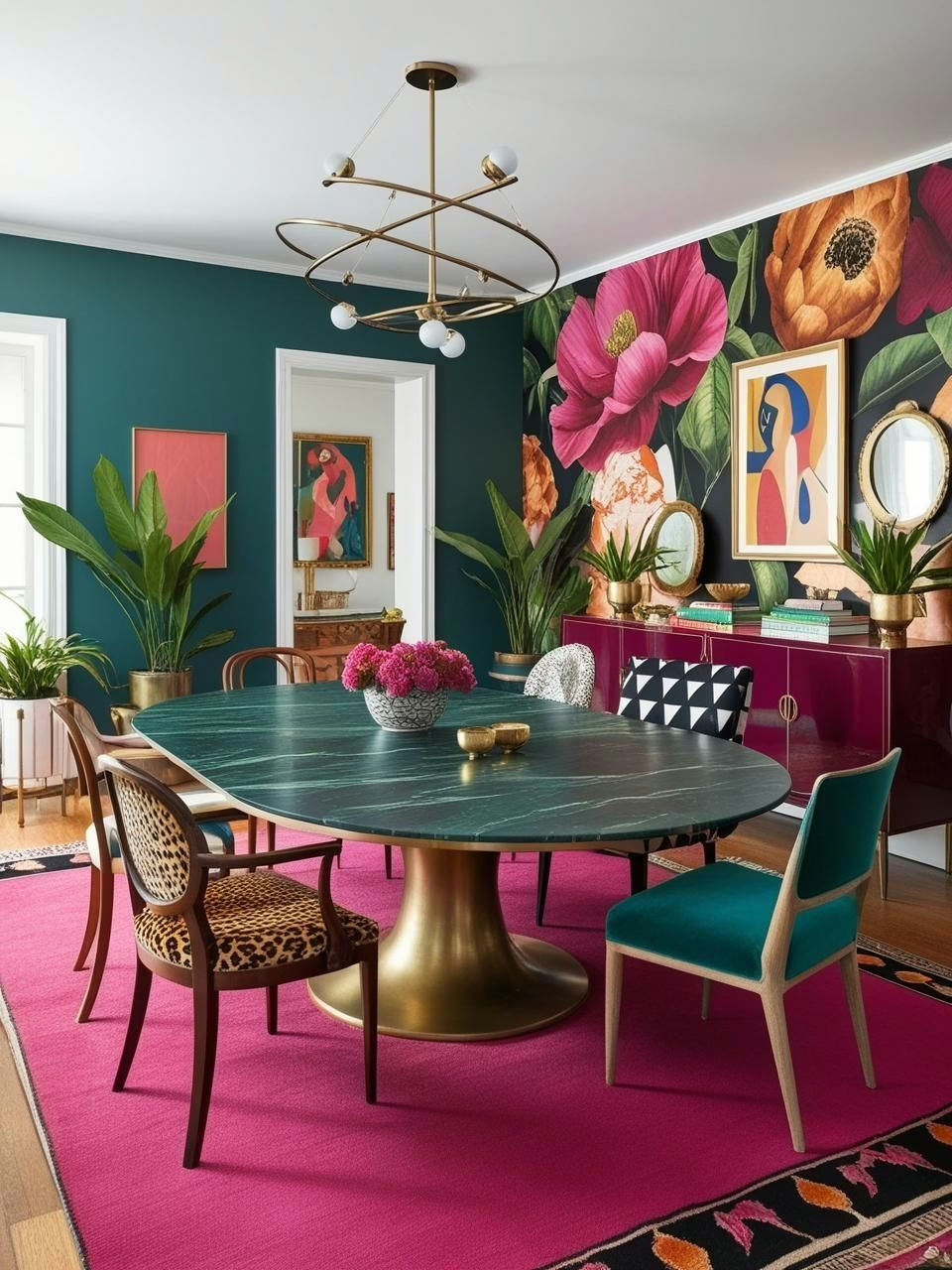
How to Maintain Functionality in a Maximalist Dining Room
Let me tell you about the time I created what I thought was the perfect maximalist dining room, only to watch in horror as red wine spilled all over a cream-colored, impossible-to-clean velvet chair. Spoiler alert: that’s when I learned that being bold doesn’t mean throwing practicality out the window!
Making Bold Choices That Last
Here’s the thing about maximalist spaces – they should be lived in, not just looked at. I learned this the hard way after designing a dining room with gorgeous but delicate wallpaper right where chair backs would constantly brush against it. Oops! Now I know better: durability and drama can totally coexist.
Some tried-and-true material combinations that actually work:
- Performance velvet upholstery (life-changing for those of us who love wine and white chairs)
- Patterned rugs that hide crumbs between cleanings (because who actually vacuums after every meal?)
- Tables with sealed surfaces that can handle hot plates and spilled sauce
- Washable wallpapers in high-traffic areas (trust me on this one)
The Clean-Up Factor
Want to know my favorite party trick? Creating a room that looks completely maxed out but can be wiped down in minutes. After years of helping clients balance their love of ornate details with their hatred of dusting, I’ve cracked the code:
Smart storage solutions that actually work:
- Hidden compartments in beautiful sideboards for placemats and napkins
- Decorative boxes that corral small items while adding to the aesthetic
- Multi-functional pieces that earn their keep (like that gorgeous cabinet that also holds your wine glasses)
Organization Without Compromise
Here’s a secret: the most functional maximalist dining rooms aren’t actually cluttered – they’re carefully curated. Remember that time I mentioned about the wine spill? Well, it taught me something else too: having a place for everything makes your bold choices shine even brighter.
My favorite organizing strategies:
- Group similar items together in way that looks intentional
- Create “zones” for different activities (dining, serving, storage)
- Use beautiful containers that add to your aesthetic instead of generic storage
- Rotate seasonal decor instead of trying to display everything at once
The Reality Check
Let’s get real for a minute – you want your dining room to be both fabulous and functional. After all, what’s the point of having a gorgeous space if you’re too nervous to actually use it? I once had a client who was so precious about her dining room that she ate in the kitchen for a year. We fixed that by making some smart material swaps, and now she hosts dinner parties twice a month.
Pro tips for keeping it real:
- Test fabric samples with actual food and drink spills before committing
- Consider how each surface will handle real-life scenarios
- Plan traffic patterns around your statement pieces
- Make sure your bold choices don’t block access to important storage
Remember that maximalist dining room with the cream velvet chairs? We recovered them in a stunning emerald performance velvet that not only survived the next wine spill but actually looked better with age. Sometimes the most practical solution is also the most beautiful – you just have to know where to look.
The ultimate goal? A dining room that makes you gasp when you walk in, but also lets you relax when you sit down. Because at the end of the day, the best maximalist spaces are the ones where you can actually live your life – spills, crumbs, and all.
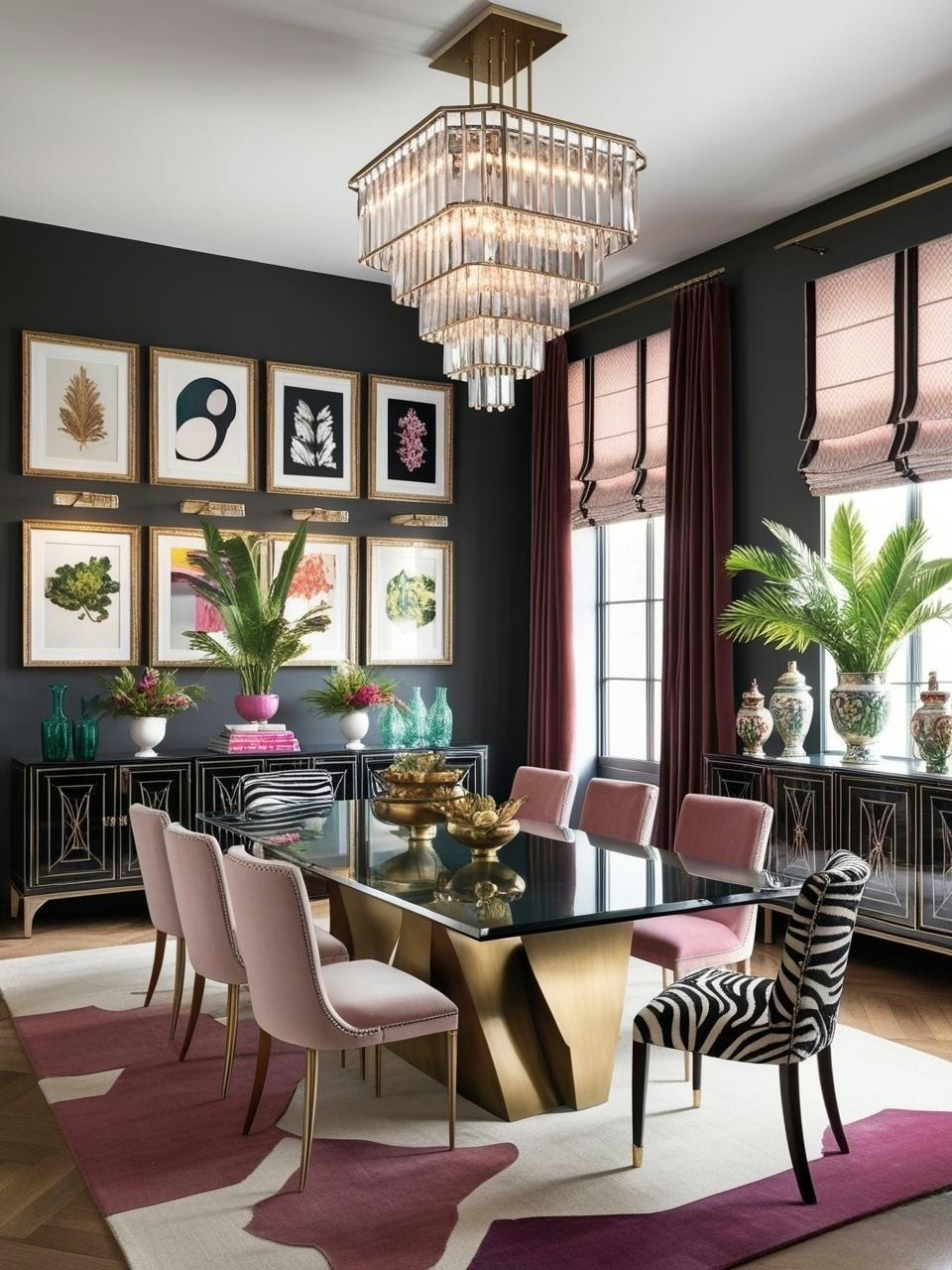
Accentuating Your Dining Room with Art and Decorative Elements
Let me tell you about the time I hung a massive abstract painting in a client’s dining room, and we both stood there thinking it was… a bit much. Then we added a vintage mirror on the opposite wall, and suddenly that “too bold” painting became the conversation starter at every dinner party. Sometimes the secret isn’t toning things down – it’s giving your bold choices the right supporting cast.
The Art of Art Selection
Here’s something that took me years to figure out: your dining room art doesn’t need to be pictures of fruit or wine bottles (revolutionary, I know!). I once helped a client hang their collection of vintage concert posters alongside a traditional oil painting, and you know what? It worked beautifully because both told stories about who they were.
Some unexpected art combinations that really sing:
- Black and white photography mixed with colorful abstract pieces
- Vintage maps alongside modern geometric prints
- Family photos treated as a gallery wall installation
- Street art prints dancing with classical landscapes
Mirror, Mirror on the Wall
Want to know my favorite trick for making art feel more intentional? Add a mirror – but not just any mirror. I’m talking about those personality-packed pieces that are art themselves. After one too many basic mirror installations, I’ve learned that mirrors in a maximalist space should never just be functional.
Mirror placement magic I’ve discovered:
- Position them to reflect your favorite art pieces (instant gallery multiplication!)
- Mix ornate vintage frames with clean-lined modern art
- Layer smaller mirrors in a collection rather than hanging one big piece
- Use mirrors strategically to bounce light around your statement pieces
The Texture Tale
Remember when I mentioned that “too bold” painting? Well, here’s what really made it work: we added layers of texture around it. Think chunky woven wall hangings, sculptural ceramic pieces, and yes, even that slightly quirky metal wall sculpture my client inherited from her aunt. Together, they created this amazing visual journey around the room.
Ways to layer in texture without chaos:
- Group similar items in unexpected ways (like a wall of varied white ceramic pieces)
- Mix materials but keep a color theme
- Use textiles as wall art (those vintage scarves you’ve been collecting? Time to frame them!)
- Create depth with a mix of flat and dimensional pieces
The Finishing Touches
Let’s talk about those little extras that make a room feel finished – you know, the ones that make people say, “How do you think of these things?” (Spoiler: usually by getting it wrong a few times first). I once spent weeks looking for the perfect sculptural centerpiece, only to realize that grouping three simple vessels at different heights created exactly the right energy.
My favorite not-so-obvious accessories:
- Vintage brass candlesticks mixed with modern glass hurricanes
- Collections displayed in unexpected ways (like those antique teacups turned into wall art)
- Plants positioned to create natural frames around art pieces
- Decorative objects that double as conversation starters
Here’s the real secret about accessorizing a maximalist dining room: it’s not about how much you add, but about creating moments that make people want to lean in for a closer look. That vintage mirror we hung opposite the bold painting? It not only reflects the art but catches the afternoon light in a way that makes the whole room feel magical at dinner time.
Remember, in a maximalist space, every piece should either tell a story or set the stage for one. And sometimes the best accessories are the ones that make you smile, even if they break all the “rules.” Because at the end of the day, the most interesting dining rooms are the ones that feel collected rather than decorated.
Unlock Designer-Perfect Colors in Minutes
Browse my curated collection of interior color palettes—tailored for today’s most loved design styles.
Embracing Your Maximalist Dining Room Journey
You know what’s funny? When I first started exploring maximalist dining rooms, I thought there was some secret formula I needed to crack – like if I just found the right ratio of patterns to solids or the perfect number of accessories, everything would magically work. But here’s what I’ve learned after helping countless clients create their dream dining spaces: the real magic happens when you stop trying to follow rules and start trusting your instincts.
Throughout this guide, we’ve explored everything from bold color choices to the perfect statement lighting, from mixing patterns to keeping things functional (because yes, wine spills happen to the best of us!). But here’s the thing – your maximalist dining room journey isn’t about copying someone else’s vision. It’s about creating a space that makes you smile every time you walk in, whether you’re grabbing a quick breakfast or hosting a dinner party.
Some parting thoughts I wish someone had told me sooner:
- Start with what you love – whether that’s a dramatic chandelier or your grandmother’s china collection
- Don’t be afraid to make mistakes (trust me, that “disaster” might lead to your best design decision yet)
- Keep what works for your life (because even the most gorgeous dining room should be lived in)
- Let your space evolve – the best maximalist rooms are the ones that grow with you
Remember that client I mentioned who was afraid her bold choices were “too much”? Well, her dining room ended up being featured in a local magazine, not because it followed any particular design rules, but because it told her story in the most authentic way possible.
So here’s my challenge to you: take these ideas and make them your own. Mix that vintage art with modern furniture. Pair those bold patterns with even bolder colors. Create a dining room that’s not just a place to eat, but a space that celebrates who you are and how you live. Because at the end of the day, the best maximalist dining rooms aren’t the ones that look perfect – they’re the ones that feel perfectly you.
And hey, if you’re ever doubting your choices, just remember: some of the most spectacular dining rooms started with someone saying, “I know this might sound crazy, but what if we…” Those are usually the moments when the magic happens.
Now, who’s ready to start creating their own maximalist masterpiece?
Curated Wall Art for Elegant Homes
Bring softness, texture, and intention into your home with digital wall art inspired by wabi-sabi, abstract forms, and muted watercolors. Every piece is crafted to create stillness and beauty—whether you’re styling a gallery wall or a minimalist nook.

